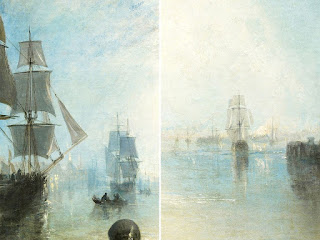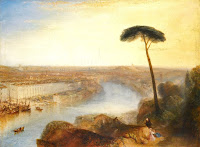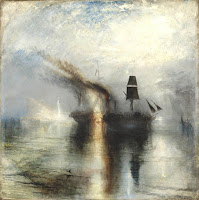Joseph Mallord William Turner’s Keelmen Heaving in Coals by Moonlight
 |
| Keelmen Heaving in Coals by Moonlight Detail of Moon, Sky and Clouds |
 |
| Keelmen Heaving in Coals by Moonlight Detail of Coal Workers |
 |
| Keelmen Heaving in Coals by Moonlight Details of Square Rigged Ships |
Keelmen Heaving in Coals by Moonlight 1835 Foreground
 |
| Shields, on the River Tyne by J. M. W. Turner (1823) |
 |
| Modern Rome – Campo Vaccino by J. M. W. Turner (1839) |
 |
| Rome, from Mount Aventine by J. M. W. Turner (1835-1836) |
 |
| Ancient Rome; Agrippina Landing with the Ashes of Germanicus by J. M. W. Turner (1839) |
Keelmen Heaving in Coals by Moonlight Analysis and Critics
 |
| The Fighting Temeraire by J. M. W. Turner (1838) |
 |
| Chichester Canal by J. M. W. Turner (1828) |
 |
| The Starry Night by Vincent van Gogh (1889) |
 |
| The Slave Ship by J. M. W. Turner (1840) |
 |
| Peace, Burial at Sea by J. M. W. Turner (1842) |
Keelmen Heaving in Coals by Night, Venice: The Dogana and San Giorgio Maggiore
 |
| Venice: The Dogana and San Giorgio Maggiore by J. M. W. Turner (1834) |
 |
| Keelmen Heaving in Coals by Moonlight Detail of Glossy Waters |
 |
| Venice: The Dogana and San Giorgio Maggiore Detail of Glossy Waters |
Beneath
the 1971 dammar varnish, traces of a prior yellowed natural resin varnish
remain. The thematic pairing “Venice: The Dogana and San Giorgio Maggiore” adds
another layer of intrigue. These canvases, two sides of a thematic coin, invite
viewers to contemplate the ebb and flow of civilizations, and the rise and fall
of empires, the transition from serenity to industry. This coupling underscores
the capacity of English romantic to weave narratives not just within individual
artworks, but across his body of work as a whole. As time continues its
unrelenting march, together with Venice: The Dogana and San Giorgio Maggiore,
Keelmen Heaving in Coals by Moonlight remains an indelible testament to the
British romantic’s creative vision. Its relevance persists, an artistic
artifact that bridges past and present, inviting us to reflect on the human
experience amidst the tide of progress. Mr. Turner’s idea to transform the ordinary
into the extraordinary, the mundane into the sublime, is an enduring reminder
of art’s capacity to capture the essence of a moment and transmute it into
eternal beauty.
Keelmen Heaving in Coals by Moonlight Meaning in Marine Art
 |
| Rain, Steam and Speed – The Great Western Railway by J. M. W. Turner (1844) |
 |
| Fishermen at Sea by J. M. W. Turner (1796) |
Keelmen Heaving in Coals by Moonlight Dimensions and Legacy
 |
| Keelmen Heaving in Coals by Moonlight Detail of Turner’s Signature |
 |
| Keelmen Heaving in Coals by Moonlight Detail of Moon’s Reflection |
 |
| Keelmen Heaving in Coals by Moonlight Detail of Small Boats |
Keelmen Heaving in Coals by Moonlight by J. M. W. Turner
 Reviewed by Articonog
on
August 10, 2023
Rating:
Reviewed by Articonog
on
August 10, 2023
Rating:
 Reviewed by Articonog
on
August 10, 2023
Rating:
Reviewed by Articonog
on
August 10, 2023
Rating:




